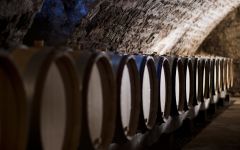Jean-Paul Droin Chablis Vaillons Premier Cru 2018
-
James
Suckling -
Jasper
Morris



Product Details
Your Rating
Somm Note
Winemaker Notes
As one of the largest land holders in the premier cru of Vaillons, the Droin family makes this wine one of the best bargains in the AOC. With its south - southeast exposure and gentle slope, Vaillons is considered, along with Montmains, to be one of the top premier crus west of the Yvonne. Benoît makes an elegant version of Vaillons that is floral and mineral, particularly in warmer vintages. Only about 20% of this wine is aged in neutral barrel with the remainder in tank.
Professional Ratings
-
James Suckling
Aromas and flavors of dried pineapple, green apple, green olive and toast. It’s medium-bodied with sharp acidity. Tight and mineral, with some beeswax notes on the finish. Drink or hold.
-
Jasper Morris
Pale lemon colour. A pleasingly tightly wound bouquet. Yuzu notes at the top, something rather more solid in white fruit behind. Not pretty at this moment but definitely with potential to go further. Pleasing persistence. The bouquet freshens up well.
Other Vintages
2021- Decanter
-
Jasper
Morris -
Robert
Parker
-
Jasper
Morris -
Robert
Parker
-
Jasper
Morris
-
James
Suckling -
Wine
Spectator -
Robert
Parker
-
Robert
Parker
-
Robert
Parker





One of the most popular and versatile white wine grapes, Chardonnay offers a wide range of flavors and styles depending on where it is grown and how it is made. While it tends to flourish in most environments, Chardonnay from its Burgundian homeland produces some of the most remarkable and longest lived examples. California produces both oaky, buttery styles and leaner, European-inspired wines. Somm Secret—The Burgundian subregion of Chablis, while typically using older oak barrels, produces a bright style similar to the unoaked style. Anyone who doesn't like oaky Chardonnay would likely enjoy Chablis.

The source of the most racy, light and tactile, yet uniquely complex Chardonnay, Chablis, while considered part of Burgundy, actually reaches far past the most northern stretch of the Côte d’Or proper. Its vineyards cover hillsides surrounding the small village of Chablis about 100 miles north of Dijon, making it actually closer to Champagne than to Burgundy. Champagne and Chablis have a unique soil type in common called Kimmeridgian, which isn’t found anywhere else in the world except southern England. A 180 million year-old geologic formation of decomposed clay and limestone, containing tiny fossilized oyster shells, spans from the Dorset village of Kimmeridge in southern England all the way down through Champagne, and to the soils of Chablis. This soil type produces wines full of structure, austerity, minerality, salinity and finesse.
Chablis Grands Crus vineyards are all located at ideal elevations and exposition on the acclaimed Kimmeridgian soil, an ancient clay-limestone soil that lends intensity and finesse to its wines. The vineyards outside of Grands Crus are Premiers Crus, and outlying from those is Petit Chablis. Chablis Grand Cru, as well as most Premier Cru Chablis, can age for many years.
